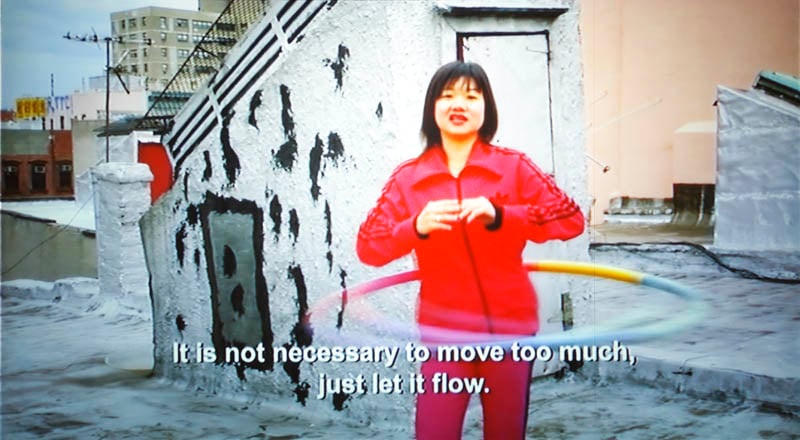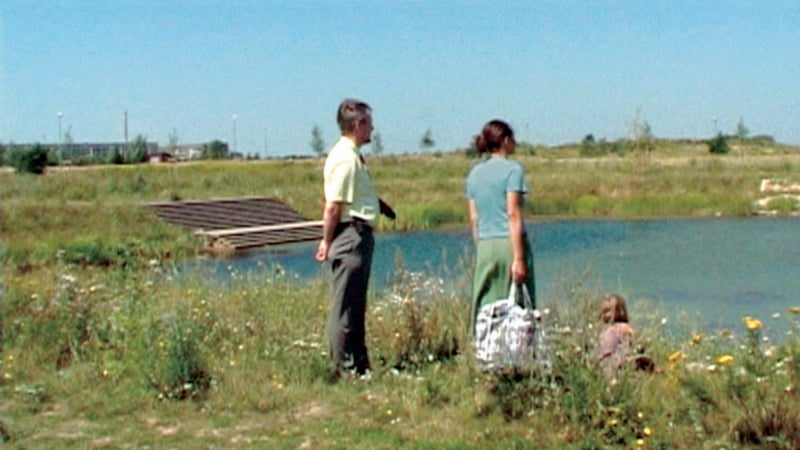
© » KADIST
Christian Jankowski
In New York City’s Chinatown, subject Suat Ling Chua’s morning exercise is to practice the hula hoop. When Christian Jankowski first saw this woman he immediately got the idea to shoot Rooftop Routine . In the short video, Chua leads the group and dictates the movements that each participant has to repeat.

© » KADIST
Clemens von Wedemeyer
Silberhöhe , directed at Halle, located in the former GDR (German Democratic Republic), is the name of a neighborhood on the outskirts of the city, which was built in the 70’s and could accommodate more 40,000 people. The opening of the film presents us with a dramatic process that transforms the documentary image. The lack of human presence makes creates a strange atmosphere in the film.

© » KADIST
Clemens von Wedemeyer
Die Siedlung is a filmic documentary about the recent shift in housing developments in Leipzig-Grünau in former East Germany and its consequences on some inhabitants. It complements von Wedemeyer slightly earlier and more artistic film Silberhöhe (2003) which decried imposed Modernist living model. In Die Siedlung , a voiceover describes and criticizes the different sites on view while the camera moves slowly past a vast abandoned 1930s Nazi army barracks which has yet to be converted or demolished, the building site and wastelands for the new private single family housing area, a constructed pond and finally the 1960s or 70s communal blocks of flats.

© » KADIST
Clemens von Wedemeyer
Clemens von Wedemeyer has imagined a trip back in time at Breitenau. Starting with events that happened there from 1933 to 1945, the German artist has composed three stories that reach the years of the women’s reformatory, in the 1970s, with a different protagonist for each era. A work that attempts to bring out the “pathology” of the site, as the artist tells Bert Rebhandl, and at the same time its “unforgettable” status as a black hole in the history of Germany, that sucked up innocent lives for almost a century.

© » KADIST
Annette Kelm
In Stilleben mid Zierlauch ( Still Life with Aluminum) Annette Kelm utilizes visual juxtaposition to bring together a gridded aluminum backdrop, a pot with a vaguely indigenous pattern on it, and two purple dandelions. The aesthetic dissonance between the mechanical, gridded aluminum and the grainy clay pot signify an interaction between systems of visual production, furthered by the aluminum grid’s inward tilt, visually apparent due to the grid pattern’s convergence at the top of the photograph. Contrasting the stark slant of the grid, the pot sits on a level surface, while the two tall stems protruding from it run at a non-parallel angle to the grid.

© » KADIST
Annette Kelm
Drawing & Print (Drawing & Print)
Percent for Art is seemingly concerned with “art enrichment” by state or city arts agencies role in it, managing the artist rosters, maintaining public art collections, commissioning artworks, selecting installation sites, among other things for aesthetic and cultural enhancement in both public and private real estate developments. For some, it’s also an opportunity to have desperately needed revenue to counter the displacement of artists and preserve a city or state’s creative spirit. The work, with its serial repetition of percentage signs across six separate bright red panels, appears as splashy retail signage for no apparent sale.

© » KADIST
Thomas Kilpper
Drawing & Print (Drawing & Print)
These two images come from the series called “State of Control” which Kilpper made in the building formerly occupied by the Stasi in Berlin. As a symbol of the past there could be none more powerful than this. By carving into its floor, Kilpper laid bare its history by making images of its occupants and political figures associated with that period of history.

© » KADIST
Ulla von Brandenburg
Eight opens with a close up of a painting by Hubert Robert of the Chateau de Chamarande where the film was shot. This work acts as a key to the unfolding film. In Eight , the camera tracks back and forth, proceeding from room to room, closing in on each motif, lingering and then passing on without ‘comment’, as a surrogate for the spectator’s gaze.

© » KADIST
Thomas Kilpper
Drawing & Print (Drawing & Print)
These two images come from the series called “State of Control” which Kilpper made in the building formerly occupied by the Stasi in Berlin. As a symbol of the past there could be none more powerful than this. By carving into its floor, Kilpper laid bare its history by making images of its occupants and political figures associated with that period of history.
Clemens von Wedemeyer
- location: Göttingen, Deutschland
- year born: 1974
- gender: male
- nationality: German
Annette Kelm
- location: Stuttgart, Deutschland
- year born: 1975
- gender: female
- nationality: German
Thomas Kilpper
- location: Stuttgart, Deutschland
- year born: 1956
- gender: male
- nationality: German
Ulla von Brandenburg
- location: Karlsruhe, Deutschland
- year born: 1974
- gender: female
- nationality: German
Christian Jankowski
- location: Göttingen, Deutschland
- year born: 1968
- gender: male
- nationality: German
-
2000-2009
Clemens von Wedemeyer
2003Silberhöhe , directed at Halle, located in the former GDR (German Democratic Republic), is the name of a neighborhood on the outskirts of the city, which was built in the 70’s and could accommodate more 40,000 people...
Clemens von Wedemeyer
2004Die Siedlung is a filmic documentary about the recent shift in housing developments in Leipzig-Grünau in former East Germany and its consequences on some inhabitants...
Ulla von Brandenburg
2007Eight opens with a close up of a painting by Hubert Robert of the Chateau de Chamarande where the film was shot...
Christian Jankowski
2008In New York City’s Chinatown, subject Suat Ling Chua’s morning exercise is to practice the hula hoop...
Thomas Kilpper
Drawing & Print
2009(Drawing & Print) These two images come from the series called “State of Control” which Kilpper made in the building formerly occupied by the Stasi in Berlin...
Thomas Kilpper
Drawing & Print
2009(Drawing & Print) These two images come from the series called “State of Control” which Kilpper made in the building formerly occupied by the Stasi in Berlin...
-
2010-2019
Annette Kelm
Drawing & Print
2013(Drawing & Print) Percent for Art is seemingly concerned with “art enrichment” by state or city arts agencies role in it, managing the artist rosters, maintaining public art collections, commissioning artworks, selecting installation sites, among other things for aesthetic and cultural enhancement in both public and private real estate developments...
Annette Kelm
2014In Stilleben mid Zierlauch ( Still Life with Aluminum) Annette Kelm utilizes visual juxtaposition to bring together a gridded aluminum backdrop, a pot with a vaguely indigenous pattern on it, and two purple dandelions...